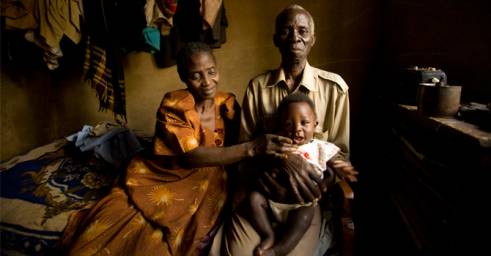By Sarah Marzouk
Today, our UK partner Age International is launching a new publication “Facing the facts: the truth about ageing and development” which brings together expert opinion on the trends, challenges and opportunities presented by a global ageing population.

Authors include Margaret Chan, Director-General of the World Health Organization, Mary Robinson, a member of The Elders, Sir Brendan Gormley, former Chief Executive of the Disasters Emergency Committee and Mark Gorman, HelpAge’s Director of Strategic Development.
Increase in “oldest old”
In 2050, just 35 years’ time, there will be more people aged 60 and over worldwide than children under 16. Today, almost two-thirds, or 62%, of the 868 million people in the world aged over 60 live in developing countries. This proportion is expected to increase to 80% in 2050.
Figures from our Global AgeWatch Index show that there is also an increase in the number of “oldest old” around the world. There are currently about 66 million people aged 80 or older living in developing countries. This is predicted to rise to around 121 million people by 2030, an increase of 82% in just 15 years.
That more people are living longer in developing countries is a cause for celebration, but this new reality also brings new challenges if it goes unrecognised.
Impact of ageing populations
New analysis from the report finds that diseases commonly associated with ageing, such as heart disease and strokes make up three of the top four causes of death in low- and middle-income countries. The increase in prevalence of these non-communicable diseases shows the need to invest in the services and programmes people require later in life.
An ageing population will affect everything from economies and labour markets to health and social care.
We support Age International’s call to the UK Government to ensure older people are included in the post-2015 sustainable development goal framework and the UK Government’s development programmes.
Chris Roles, Director of Age International, said: “Our analysis highlights how population ageing affects every aspect of development, but simply isn’t being given the attention it deserves. We need policies that are fit for the world around us and the future ahead, not ones based on out of date views of who lives in developing countries.
“For example, our experience tells us that older people are far too often invisible in emergency humanitarian situations as well as longer term development programmes. Ignoring the ageing population is no longer an option.”
Older people have a lifetime of experience
Margaret Chan said: “The health needs of the world’s population are being transformed by global ageing yet governments, development and health practitioners have been slow to react. The increase in the number of older people is one of the success stories of international development and how we respond to this reality will be one of the keys to prosperity in the future.”
Older people have a lifetime of skills and experience, and most continue to contribute to local economies through paid or unpaid employment. Many also have valuable roles caring for or raising children.
For example, up to 60% of children orphaned by AIDS in Zimbabwe and Namibia are raised by their grandparents. “Facing the facts” draws attention to the wide range of social and economic benefits older people bring to their communities and challenges negative stereotypes of ageing.
